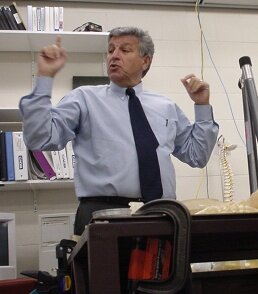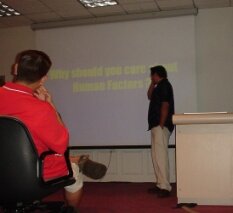 The main researcher telling us about the computer and modeling machine |
 The main researcher telling us about the computer and modeling machine |
 A section of a human skull, reproduced by a computer based on a CAT scan. The pink mass is a dense tumor. |
| The next lab that we visited was a driving simulation lab, basically a home-made version of a driving arcade game with real-world based scenarios vs. thrill based scenarios. |  |
 Upon the conclusion of lunch, we all followed our numbered-flag baring guides back to our assigned busses to continue the tours. Our first afternoon stop was at another, smaller scale virtual reality lab. As an introduction, a grad student talked about human factors and why they were cool. He never bothered to define the term, but I gather that human factors are the basic outline, limits, and functions of a human that engineers need to consider when designing stuff.
Upon the conclusion of lunch, we all followed our numbered-flag baring guides back to our assigned busses to continue the tours. Our first afternoon stop was at another, smaller scale virtual reality lab. As an introduction, a grad student talked about human factors and why they were cool. He never bothered to define the term, but I gather that human factors are the basic outline, limits, and functions of a human that engineers need to consider when designing stuff.  The second speaker was a former military employee who was now working on developing a cheep "school shooting" training simulation. Afterwards, we observed several simulation and VR projects, mainly interface tools like head gear and devices that track body movement.
The second speaker was a former military employee who was now working on developing a cheep "school shooting" training simulation. Afterwards, we observed several simulation and VR projects, mainly interface tools like head gear and devices that track body movement. Our last tour was of a cancer research facility, where we were split up into 4 groups and rotated through. My group began in the plant genetics room, where they were trying to grow plants that produced or were immune to certain pesticides and/or antibiotics.
Our last tour was of a cancer research facility, where we were split up into 4 groups and rotated through. My group began in the plant genetics room, where they were trying to grow plants that produced or were immune to certain pesticides and/or antibiotics.  Our second stop was in a small room to see one of their more advanced microscopes. The scope and its software had the capability to take and pictures of many layers of a slide and compile them into a 3-d image. Equipped with several lasers, the scope was able to also capture an image of the dispersal and arrangement of any marked proteins within a cell. Another demo was given for another scope that was different in methods but similar in end results to the first scope.
Our second stop was in a small room to see one of their more advanced microscopes. The scope and its software had the capability to take and pictures of many layers of a slide and compile them into a 3-d image. Equipped with several lasers, the scope was able to also capture an image of the dispersal and arrangement of any marked proteins within a cell. Another demo was given for another scope that was different in methods but similar in end results to the first scope.  The last leg of the tour took us to the DNA room, where they had and showed us the processes and equipment used to sequence DNA.
The last leg of the tour took us to the DNA room, where they had and showed us the processes and equipment used to sequence DNA.